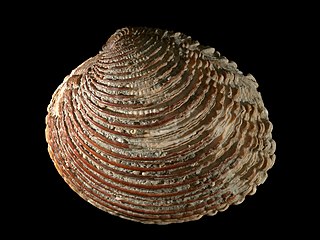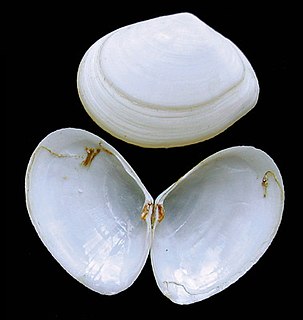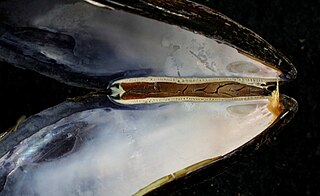
The humerus is a long bone in the arm that runs from the shoulder to the elbow. It connects the scapula and the two bones of the lower arm, the radius and ulna, and consists of three sections. The humeral upper extremity consists of a rounded head, a narrow neck, and two short processes. The body is cylindrical in its upper portion, and more prismatic below. The lower extremity consists of 2 epicondyles, 2 processes, and 3 fossae. As well as its true anatomical neck, the constriction below the greater and lesser tubercles of the humerus is referred to as its surgical neck due to its tendency to fracture, thus often becoming the focus of surgeons.

Henri Marie Ducrotay de Blainville was a French zoologist and anatomist.

The Veneridae or venerids, common name: venus clams, are a very large family of minute to large, saltwater clams, marine bivalve molluscs. Over 500 living species of venerid bivalves are known, most of which are edible, and many of which are exploited as food sources.

The body of the sphenoid bone, more or less cubical in shape, is hollowed out in its interior to form two large cavities, the sphenoidal sinuses, which are separated from each other by a septum.
The Ochlockonee moccasinshell is a species of freshwater mussel, an aquatic bivalve mollusk in the family Unionidae, the river mussels.

Cystiscus is a taxonomic genus of minute sea snails, marine gastropod mollusks or micromollusks.

A bivalve shell is part of the body, the exoskeleton or shell, of a bivalve mollusk. In life, the shell of this class of mollusks is composed of two hinged parts or valves. Bivalves are very common in essentially all aquatic locales, including saltwater, brackish water, and freshwater. The shells of bivalves commonly wash up on beaches and along the edges of lakes, rivers, and streams. Bivalves by definition possess two shells or valves, a "right valve" and a "left valve", that are joined by a ligament. The two valves usually articulate with one another using structures known as "teeth" which are situated along the hinge line. In many bivalve shells, the two valves are symmetrical along the hinge line—when truly symmetrical, such an animal is said to be equivalved; if the valves vary from each other in size or shape, inequivalved. If symmetrical front-to-back, the valves are said to be equilateral, and are otherwise considered inequilateral.

Pleurobranchaea meckeli is a species of sea slug, specifically a side gill slug or notaspideans. It is a marine gastropod mollusc in the family Pleurobranchaeidae.
Helcionopsis subcarinata is an extinct species of paleozoic monoplacophoran in the family Tryblidiidae.

Sharpirhynchia sharpi is a species of extinct, small-sized lampshell, named after Samuel Sharp (1814–1882), an early fossil collector, who discovered the limited time span of some fossils, now known as index fossils. S. sharpi is a marine rhynchonellate brachiopod in the family Rhynchonellidae. It is roughly ½ inch (1.25 cm) measured along the axis, with a slender beak, the brachial valve more convex than the pedunculate valve, and it has 21–31 ribs fanning out from the hinge.

Rhynchonelloidella alemanica is a species of extinct, small-sized brachiopod, a marine rhynchonellate lampshell in the family Rhynchonellidae. It is roughly 9/16 inch (1.4 cm), and has about 15 ribs fanning out from the hinge.

A hinge ligament is a crucial part of the anatomical structure of a bivalve shell, i.e. the shell of a bivalve mollusk. The shell of a bivalve has two valves and these are joined together by the ligament at the dorsal edge of the shell. The ligament is made of a strong, flexible and elastic, fibrous, proteinaceous material which is usually pale brown, dark brown or black in color.

Thracia is a genus of bivalve mollusc in the family Thraciidae.
Thracia pubescens is a bivalve mollusc in the family Thraciidae.
Cyathodonta plicata is a bivalve mollusc in the family Thraciidae.
Thracia phaseolina is a bivalve mollusc in the family Thraciidae.

Fusconaia burkei is a species of freshwater mussel, an aquatic bivalve mollusk in the family Unionidae, the river mussels.

Coriocella nigra is a species of sea snail, a marine gastropod mollusk in the family Velutinidae. An Indo-Pacific species, it lives on rocks at depths of up to 15 m. It is up to 10 cm long and has an internal shell; body color is black or brown. C. nigra is probably a predator of tunicates.

Nassodonta dorri is a species of brackish water snail, with gills and an operculum, a gastropod mollusk in the family Nassariidae, the nassa mud snails or dog whelks.

Compsodrillia tricatenaria is an extinct species of sea snail, a marine gastropod mollusk in the family Pseudomelatomidae, the turrids and allies.














